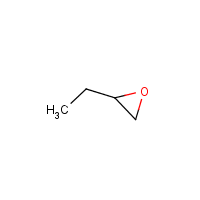1,2-Epoxybutane
Agent Name
1,2-Epoxybutane
Alternative Name
1,2-Butylene oxide
CAS Number
106-88-7
Formula
C4-H8-O
Major Category
Plastics & Rubber

Synonyms
1,2-Butylene oxide; ( -)-Ethyloxirane; (+-)-2-Ethyloxirane; 1,2-Butene oxide; 1,2-Butene oxide (VAN); 1,2-Monoepoxybutane; 1-Butylene oxide; 2-Ethyloxirane; Butane, 1,2-epoxy-; DL-1,2-Epoxybutane; Ethyl ethylene oxide; Ethylene oxide, ethyl-; Ethylethylene oxide; Ethyloxirane; Oxirane, ethyl-; alpha-Butylene oxide; n-Butene-1,2-oxide; [ChemIDplus] UN3022
Category
Epoxides
Description
Colorless liquid with a characteristic odor; [ICSC] Colorless liquid with an unpleasant odor; May decompose on exposure to moisture; [MSDSonline]
Sources/Uses
Used to make polymers; Also used as a stabilizer and acid scavenger for chlorinated solvents and a corrosion inhibitor; [HSDB]
Comments
A skin, eye, and respiratory tract irritant; Inhalation of high concentrations can cause CNS depression; [ICSC] Danger of cutaneous absorption; [MAK] Toxic by inhalation at room temperature; [Hawley] Liquid or vapor can burn eyes; May cause skin sensitization; [CAMEO] A corrosive substance that can cause injury to the skin, eyes, and respiratory tract; Inhalation may cause chemical pneumonitis and pulmonary edema; [MSDSonline] No data available on human exposure to the pure substance; [AIHA] 1,2-Butylene oxide, stabilized (UN3022) has warning of explosive polymerization; [ERG 2016] See "Ethylene oxide."
Biomedical References
Exposure Assessment
Vapor Pressure
180 mm Hg
Odor Threshold Low
0.07 ppm
Odor Threshold High
0.71 ppm
Lethal Concentration
LC50 (rat) = 6,300 mg/m3/4h
Explosive Polymerization
Yes
Explanatory Notes
Flash point = -22 deg C; [ICSC] Odor threshold low (absolute perception limit), and high (recognition) from CHEMINFO; The Guide from the Emergency Response Guidebook is for "1,2-Butylene oxide, stabilized." VP from ChemIDplus;
NFPA
may ignite at ambient temp
WEEL
2 ppm
Adverse Effects
Toxic Pneumonitis
Yes
Neurotoxin
Other CNS neurotoxin
Dermatotoxin
Skin burns
IARC Carcinogen
Possible (2b)
Diseases, Processes, and Activities Linked to This Agent
Diseases
Occupational diseases associated with exposure to this agent: